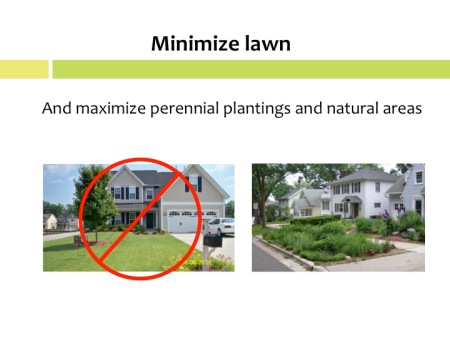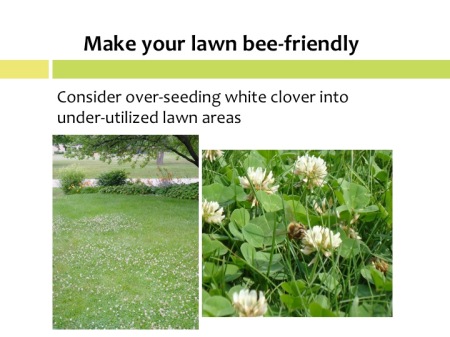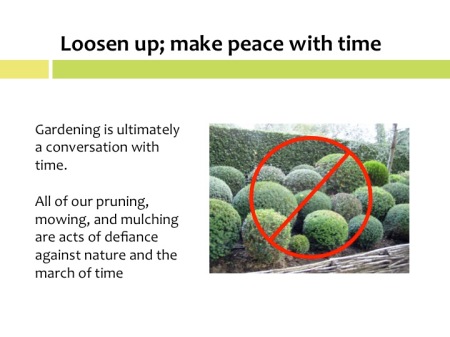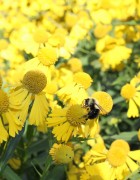Simple Tips for Creating a Pollinator-Friendly Landscape
by Annie S. White
A landscape rich with a diversity of flowering plants is both beautiful and helps support the thousands of species of bees, butterflies, hummingbirds, and other pollinating insects we have in the U.S. However, planning your pollinator-friendly landscape does not end with your plant list. The layout of your gardens, layout of your plants, and your maintenance practices all affect pollinators. Here is a set of considerations for choosing the best types of plants for pollinators, plus how to use them to create the best pollinator sanctuary possible.
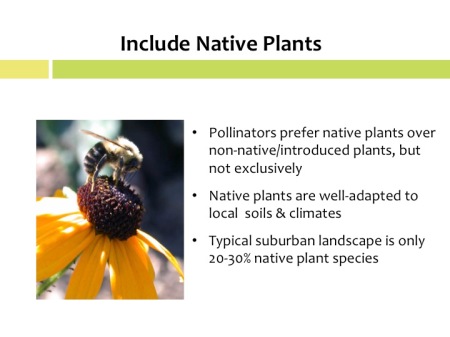
Research suggests that most pollinators prefer to forage—but not necessarily exclusively—on the nectar and pollen from native plants. There are plenty of non-native species that are also great for pollinators, so it is not necessary to avoid them altogether, but incorporating more native plants into your landscape will make the pollinators, as well as the birds and other wildlife, happiest. A typical suburban landscape contains only 20-30% native plant species. Try reversing that trend in your own landscape by using 70-80% native species.
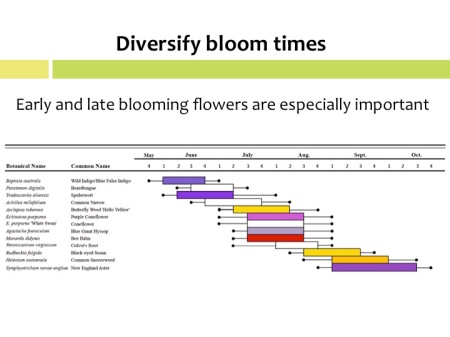 A pollinator-friendly landscape has flowers in bloom throughout the entire growing season, providing a consistent supply of nectar and pollen. When choosing plants, it is especially important to have plants that bloom early in the spring, such as a serviceberry tree (Amelanchier spp.) or wild columbine (Aquilegia canadensis), and late in the fall, such as Asters (Symphyotrichum spp.). In addition to perennial flowers, many flowering trees and shrubs, annuals, and spring bulbs are also beneficial to pollinators.
A pollinator-friendly landscape has flowers in bloom throughout the entire growing season, providing a consistent supply of nectar and pollen. When choosing plants, it is especially important to have plants that bloom early in the spring, such as a serviceberry tree (Amelanchier spp.) or wild columbine (Aquilegia canadensis), and late in the fall, such as Asters (Symphyotrichum spp.). In addition to perennial flowers, many flowering trees and shrubs, annuals, and spring bulbs are also beneficial to pollinators.

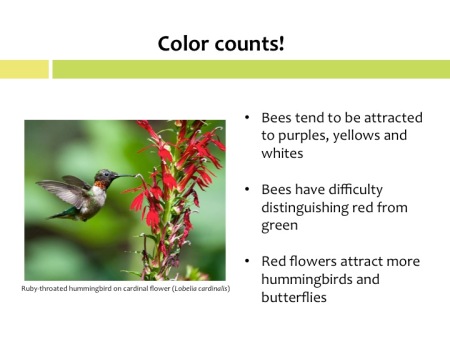 The size, shape, and color of flowering plants all influence what types of pollinating insects will visit, so planting a diversity of flowers is the best way to attract a diversity of pollinators. For example, bees are more attracted to purple, yellow, and white flowers and less attracted to red flowers. However, red flowers, such as scarlet bee balm (Monarda didyma) and cardinal flower (Lobelia cardinalis), are magnets for butterflies and hummingbirds.
The size, shape, and color of flowering plants all influence what types of pollinating insects will visit, so planting a diversity of flowers is the best way to attract a diversity of pollinators. For example, bees are more attracted to purple, yellow, and white flowers and less attracted to red flowers. However, red flowers, such as scarlet bee balm (Monarda didyma) and cardinal flower (Lobelia cardinalis), are magnets for butterflies and hummingbirds.
Many of our small native bees prefer to forage on small flowers such as yarrow (Achillea spp.) or composite flowers comprised of many tiny florets, like purple coneflowers (Echinacea purpurea). Bumblebees are big and strong, allowing them to pry their way inside larger flowers such as wild indigo (Baptisia spp.) that are difficult for other bees to access. Planting a variety of flower shapes and sizes will ensure all pollinators are well fed.
Some moths and butterflies also use plants in our gardens as host plants to rear their young. The monarch butterfly will feed on the nectar of many flowers but will only lay their eggs on the leaves of milkweed (Asclepias spp.). Include host plants such as marsh milkweed (Asclepias incarnata), butterfly milkweed (Asclepias tuberosa), and wild lupine (Lupinus perennis) in your gardens to help support rare butterflies.
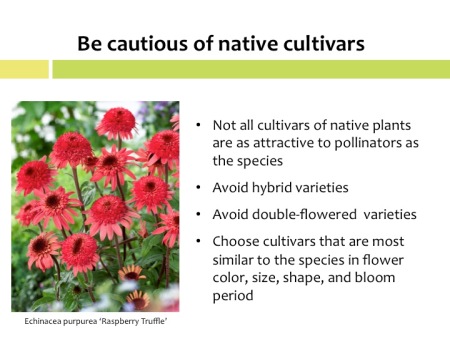 When shopping for native plants at nurseries and garden centers, you will find that there are numerous cultivars available for native plants. For example if you are looking for purple coneflower (Echinacea purpurea), you may find dozens of cultivars such as Echinacea purpurea ‘PowWow Wild Berry’ and Echinacea purpurea ‘White Swan.’ Research has shown that some cultivars are not as attractive to pollinators as their wild ancestors, so choose cultivars carefully. As a general rule of thumb it is best to avoid hybrid cultivars, double-flowered cultivars, and cultivars that have a dramatic change in color or flower shape.
When shopping for native plants at nurseries and garden centers, you will find that there are numerous cultivars available for native plants. For example if you are looking for purple coneflower (Echinacea purpurea), you may find dozens of cultivars such as Echinacea purpurea ‘PowWow Wild Berry’ and Echinacea purpurea ‘White Swan.’ Research has shown that some cultivars are not as attractive to pollinators as their wild ancestors, so choose cultivars carefully. As a general rule of thumb it is best to avoid hybrid cultivars, double-flowered cultivars, and cultivars that have a dramatic change in color or flower shape.
Ask your nursery if the plants you are buying have been treated with a systemic insecticide, such as neonicotinoids, within the last year. Scientists are currently studying and debating how dangerous these common insecticides are for bees, especially honeybees. But here is what we already know: systemic insecticides are absorbed into the plant’s tissues and can be transported to the nectar and pollen. High concentrations can be fatal to bees, butterflies, and other insect pollinators, and lower concentrations may affect their health and well-being. If your gardening efforts are motivated by a desire to support pollinator populations, it is best to avoid buying plants that have been treated with systemic insecticides, and of course, avoid applying insecticides in your landscape as well.
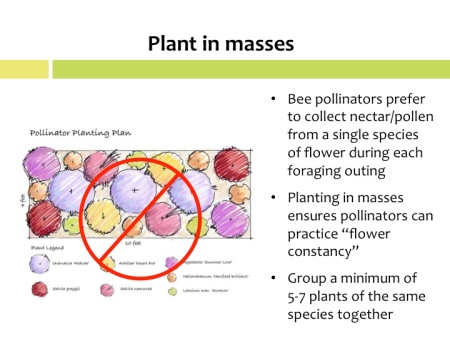 Many bee pollinators prefer to forage on the nectar and pollen from a single plant species during their foraging outings. Bee biologists call this “flower constancy.” Therefore, grouping plants in single-species masses of five to seven plants is more advantageous for the bees than having just one or two plants or dispersing them throughout the landscape.
Many bee pollinators prefer to forage on the nectar and pollen from a single plant species during their foraging outings. Bee biologists call this “flower constancy.” Therefore, grouping plants in single-species masses of five to seven plants is more advantageous for the bees than having just one or two plants or dispersing them throughout the landscape.
Having pollinator-friendly flowering plants is just one aspect to creating a permanent habitat in your yard. Pollinators also need homes to raise their families. Honeybees are the only species that live in human-constructed hives. Of the 4,000 species of native bees we have here in the U.S. about 70% nest in burrows in the ground and the rest build their homes in hollowed twigs or pithy stems.
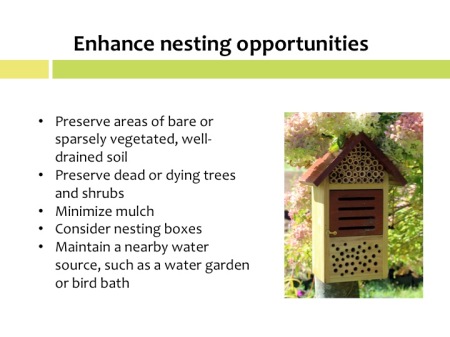 Preserving bare areas of well-drained soil in sunny locations and minimizing the use of mulch will help ground-nesting bees find permanent homes in your gardens. Brush piles and dead or dying trees and shrubs also make great homes for pollinators, but if you like your landscape neat and tidy, you can make (or purchase) pollinator-nesting boxes. A water source, such as a birdbath with a shallow area, is also an appreciated addition to any pollinator-friendly landscape.
Preserving bare areas of well-drained soil in sunny locations and minimizing the use of mulch will help ground-nesting bees find permanent homes in your gardens. Brush piles and dead or dying trees and shrubs also make great homes for pollinators, but if you like your landscape neat and tidy, you can make (or purchase) pollinator-nesting boxes. A water source, such as a birdbath with a shallow area, is also an appreciated addition to any pollinator-friendly landscape.
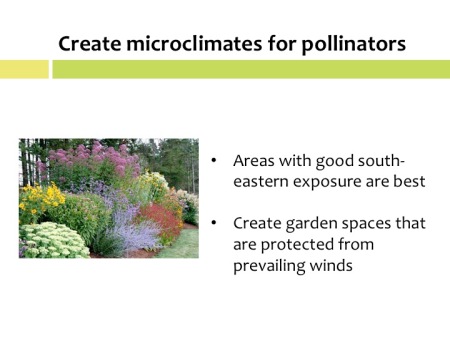 You have probably noticed that you see more bees and butterflies in your garden on warm, sunny, and calm days. You can create microclimates within your landscape that will keep the bees buzzing even on not-so-perfect days. A garden space that is rich with a diversity of flowering plants and also has good southeastern exposure for morning and mid-day sun and is protected from prevailing winds is the perfect sanctuary for pollinators.
You have probably noticed that you see more bees and butterflies in your garden on warm, sunny, and calm days. You can create microclimates within your landscape that will keep the bees buzzing even on not-so-perfect days. A garden space that is rich with a diversity of flowering plants and also has good southeastern exposure for morning and mid-day sun and is protected from prevailing winds is the perfect sanctuary for pollinators.
Here are a few more design tips for creating beautiful and pollinator-friendly landscapes:
